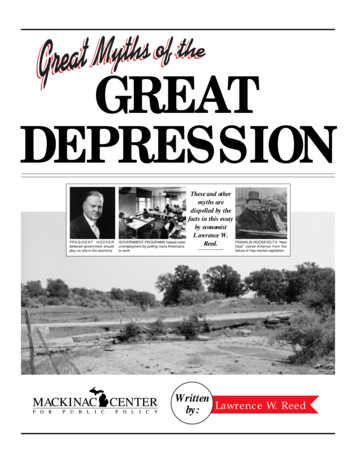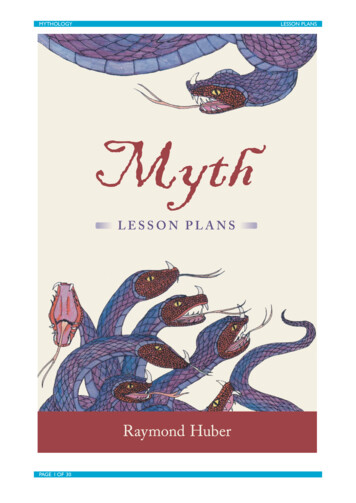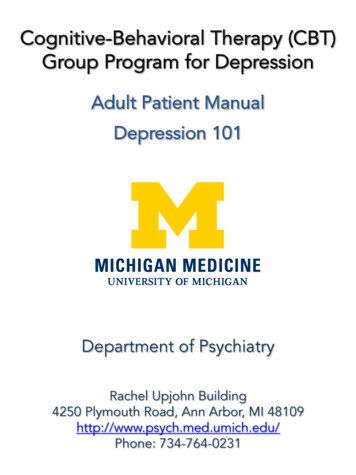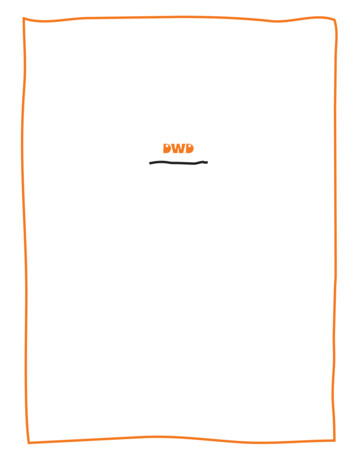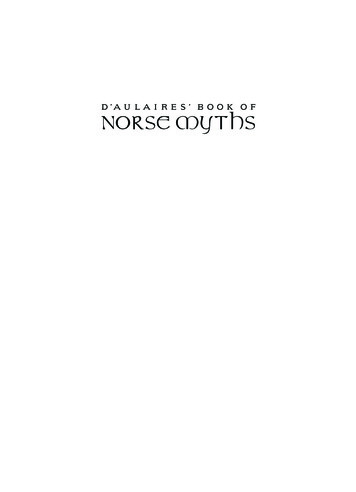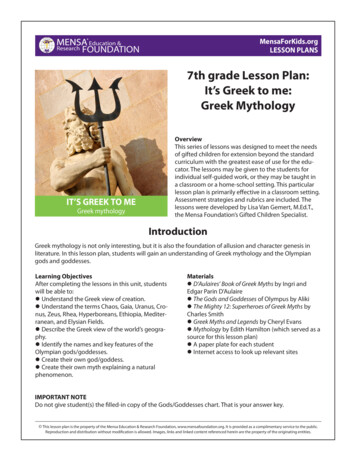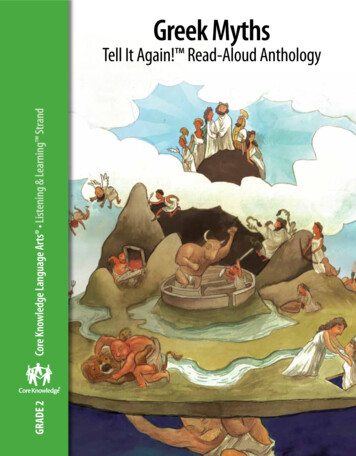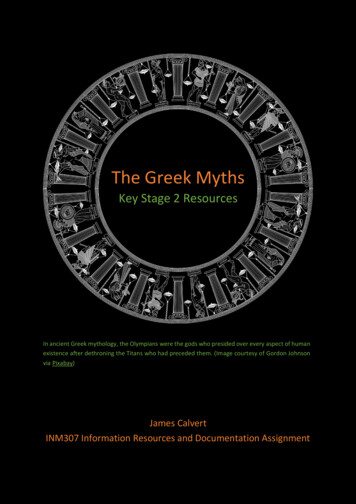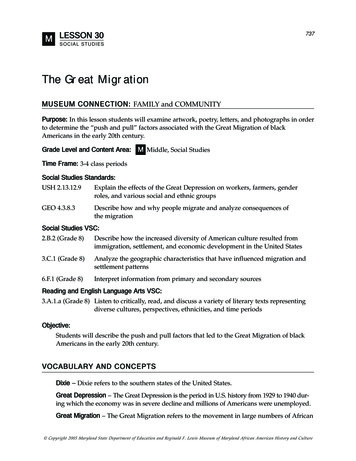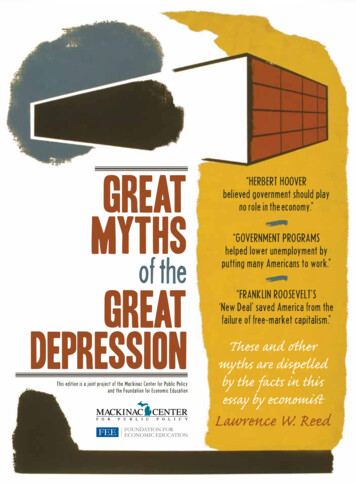
Transcription
Mackinac Center for Public Policy Great Myths of the Great DepressionGreatMythsof theGreatDepressionThis edition is a joint project of the Mackinac Center for Public Policyand the Foundation for Economic Education1“HERBERT HOOVERbelieved government should playno role in the economy.”“GOVERNMENT PROGRAMShelped lower unemployment byputting many Americans to work.”“FRANKLIN ROOSEVELT’S‘New Deal’ saved America from thefailure of free-market capitalism.”These and othermyths are dispelledby the facts in thisessay by economistLawrence W. Reed
Mackinac Center for Public Policy Great Myths of the Great Depression2To James M. Rodneya great friend of truth, character and libertyGreat Myths of the Great Depression by Lawrence W. Reed. Original edition printed in 1981.This edition was printed in 2010 as a joint project of the Mackinac Center and the Foundation for Economic Education.
Mackinac Center for Public Policy Great Myths of the Great Depression1Great Myths of the Great DepressionStudents today are often given a skewed account of the Great Depression of 1929-1941 thatcondemns free-market capitalism as the cause of, and promotes government intervention as thesolution to, the economic hardships of the era. In this essay based on a popular lecture, MackinacCenter for Public Policy President Lawrence W. Reed debunks the conventional view and traces thecentral role that poor government policy played in fostering this legendary catastrophe.IntroductionMany volumes have been writtenabout the Great Depression of1929-1941 and its impact on thelives of millions of Americans.Historians, economists andpoliticians have all combed thewreckage searching for the “blackbox” that will reveal the cause ofthe calamity. Sadly, all too manyof them decide to abandon theirsearch, finding it easier perhapsto circulate a host of false andharmful conclusions about theevents of seven decades ago.Consequently, many peopletoday continue to accept critiquesof free-market capitalism thatare unjustified and supportgovernment policies that areeconomically destructive.How bad was the GreatDepression? Over the four yearsfrom 1929 to 1933, production atthe nation’s factories, mines andutilities fell by more than half.People’s real disposable incomesdropped 28 percent. Stock pricescollapsed to one-tenth of theirpre-crash height. The numberof unemployed Americans rosefrom 1.6 million in 1929 to 12.8million in 1933. One of everyfour workers was out of a job atthe Depression’s nadir, and uglyrumors of revolt simmered for thefirst time since the Civil War.“The terror of the Great Crashhas been the failure to explain it,”writes economist Alan Reynolds.“People were left with thefeeling that massive economiccontractions could occur atany moment, without warning,without cause. That fear hasbeen exploited ever since as themajor justification for virtuallyunlimited federal interventionin economic affairs.”1Old myths never die; they justkeep showing up in economicsand political science textbooks.Wi t h o n l y a n o c c a s i o n a lexception, it is there you will findwhat may be the 20th century’sg re ate st my th: C apit ali smand the free-market economywere responsible for the GreatDepression, and only governmentinter vention brought aboutAmerica’s economic recovery.A Modern Fairy TaleAccording to this simplisticperspective, an important pillarTHE GREAT DEPRESSION devastated everypart of America, even its smallest towns.of capitalism, the stock market,crashed and dragged Americainto depression. PresidentHerbert Hoover, an advocateof “hands-off,” or laissez-faire,economic policy, refused to usethe power of government andconditions worsened as a result.It was up to Hoover’s successor,Franklin Delano Roosevelt,to ride in on the white horseof government interventionand steer the nation towardrecovery. The apparent lessonto be drawn is that capitalismcannot be trusted; governmentneeds to take an active role inthe economy to save us frominevitable decline.But those who propagate thisversion of history might justas well top off their remarksby saying , “And Goldilocksfound her way out of the forest,
Mackinac Center for Public Policy Great Myths of the Great Depression2Dorothy made it from Oz backto Kansas, and Little Red RidingHood won the New York StateLottery.” The popular account ofthe Depression as outlined abovebelongs in a book of fairy talesand not in a serious discussionof economic history.THe Great,Great,Great,GreatDepressionTo properly understand theevents of the time, it is factuallyappropriate to view the GreatDepression as not one, but fourconsecutive downturns rolled intoone. These four “phases” are:2I.Monetary Policy and theBusiness CycleII.The Disintegration of theWorld EconomyIII. The New DealIV. The Wagner ActThe first phase covers why thecrash of 1929 happened in thefirst place; the other three showhow government interventionworsened it and kept the economyin a stupor for over a decade. Let’sconsider each one in turn.Phase I:The Business CycleThe Great Depression was not thecountry’s first depression, thoughit proved to be the longest.Several others preceded it.A common thread woven throughall of those earlier debaclesPeople who argue that the free-marketeconomy collapsed of its own weight inthe 1930s seem utterly unaware of thecritical role played by the Federal ReserveSystem’s gross mismanagement of moneyand credit.was disastrous intervention bygovernment, often in the formof political mismanagement ofthe money and credit supply.None of these depressions,however, lasted more than fouryears and most of them wereover in two. The calamity thatbegan in 1929 lasted at leastthree times longer than any of thecountry’s previous depressionsbecause the governmentcompounded its initial errors witha series of additional and harmfulinterventions.Central Planners Failat Monetary PolicyA popular explanation for thestock market collapse of 1929concerns the practice of borrowingmoney to buy stock. Many historytexts blithely assert that a frenziedspeculation in shares was fed byexcessive “margin lending.” ButMarquette University economistGene Smiley, in his 2002 book“Rethinking the Great Depression”,explains why this is not a fruitfulobservation:There was already a longhistory of margin lending onstock exchanges, and marginrequirements — the shareof the purchase price paid incash — were no lower in thelate twenties than in the earlytwenties or in previous decades.In fact, in the fall of 1928 marginrequirements began to rise, andborrowers were required to paya larger share of the purchaseprice of the stocks.The margin lending argumentdoesn’t hold much water. Mischiefwith the money and credit supply,however, is another story.Most monetary economists,particularly those of the “AustrianSchool,” have observed the closerelationship between moneysupply and economic activity.When government inflates themoney and credit supply, interestrates at first fall. Businessesinvest this “easy money” in newproduction projects and a boomtakes place in capital goods. Asthe boom matures, businesscosts rise, interest rates readjustupward, and profits are squeezed.The easy-money effects thus wearoff and the monetary authorities,fearing price inflation, slow thegrowth of, or even contract, themoney supply. In either case,the manipulation is enough toknock out the shaky supportsfrom underneath the economichouse of cards.One prominent interpretationof the Federal Reserve System’sactions prior to 1929 can be found
Mackinac Center for Public Policy Great Myths of the Great Depression3in “America’s Great Depression”by economist Murray Rothbard.Using a broad measure thatincludes currenc y, demandand time deposits, and otheringredients, he estimated that theFed bloated the money supply bymore than 60 percent from mid1921 to mid-1929.3 Rothbardargued that this expansion ofmoney and credit drove interestrates down, pushed the stockmarket to dizzy heights, and gavebirth to the “Roaring Twenties.”Reckless money and credit growthconstituted what economistBenjamin M. Anderson called“the beginning of the New Deal”4— the name for the better-knownbut highly interventionist policiesthat would come later underPresident Franklin Roosevelt.However, other scholars raisedoubts that Fed action wasas inflationary as Rothbardbelieved, pointing to relativelyflat commodity and consumerprices in the 1920s as evidencethat monetary policy was not sowildly irresponsible.Substantial cuts in highmarginal income tax rates inthe Coolidge years certainlyhelped the economy and mayhave ameliorated the pricee f f e c t o f Fe d p o l i c y. Ta xreductions spurred investmentand real economic growth,which in turn yielded a burst oftechnological advancement andentrepreneurial discoveries ofcheaper ways to produce goods.This explosion in productivityundoubtedly helped to keepUnemployment skyrocketed after Congress raised tariffs and taxes in the early 1930s andstayed high as policies of the Roosevelt administration discouraged investment and recoveryduring the rest of the decade.prices lower than they wouldhave otherwise been.Regarding Fed policy, freemarket economists who differ onthe extent of the Fed’s monetaryexpansion of the early and mid1920s are of one view aboutwhat happened next: The centralbank presided over a dramaticcontraction of the money supplythat began late in the decade. Thefederal government’s responsesto the resulting recession tooka bad situation and made it far,far worse.The Bottom Drops OutBy 1928, the Federal Reservewas raising interest rates andchoking off the money supply.For example, its discount rate(the rate the Fed charges memberbanks for loans) was increasedfour times, from 3.5 percent to6 percent, between January 1928and August 1929. The centralbank took further deflationaryaction by aggressively sellinggover nment s e c ur itie s formonths after the stock marketcrashed. For the next three years,the money supply shrank by 30percent. As prices then tumbledthroughout the economy, theFed’s higher interest rate policyboosted real (inflation-adjusted)rates dramatically.Th e m o s t c o m p r e h e n s i v echronicle of the monetar ypolicies of the period can befound in the classic work of NobelLaureate Milton Friedman andhis colleague Anna Schwartz,“A Monetary History of the UnitedStates”, 1867-1960. Friedman andSchwartz argue conclusively thatthe contraction of the nation’smoney supply by one-thirdbetween August 1929 and March1933 was an enormous drag onthe economy and largely the resultof seismic incompetence by theFed. The death in October 1928
Mackinac Center for Public Policy Great Myths of the Great Depressionof Benjamin Strong, a powerfulfigure who had exerted greatinfluence as head of the Fed’sNew York district bank, left theFed floundering without capableleadership — making bad policyeven worse.5At first, only the “smart” money— the Bernard Baruchs and theJoseph Kennedys who watchedthings like money supply andother government policies —saw that the party was comingto an end. Baruch actuallybegan selling stocks and buyingbonds and gold as early as1928; Kennedy did likewise,commenting, “only a fool holdsout for the top dollar.”6The masses of investorseventually sensed the changea t t h e Fe d a n d t h e n t h estampede began. In a specialissue commemorating the 50thanniversary of the stock marketcollapse, U.S. News & WorldReport described it this way:Actually the Great Crashwas by no means a oneday affair, despite frequentreferences to Black Thursday,October 24, and the followingweek’s Black Tuesday. Asearly as September 5, stockswere weak in heavy trading,after having moved into newhigh ground two days earlier.Declines in early Octoberwere calle d a “desirablecorrection.” The Wall StreetJournal, predicting an autumnrally, noted that “some stocksrise, some fall.”4Then, on October 3,stocks suffered their worstpummeling of the ye ar.Margin calls went out; sometraders grew apprehensive.But the next day, prices roseagain and thereafter seesawedfor a fortnight.The real crunch began onWednesday, October 23, withwhat one observer called “aNiagara of liquidation.” Sixmillion shares changed hands.The industrial average fell 21points. “Tomorrow, the turnwill come,” brokers told oneanother. Prices, they said, hadbeen carried to “unreasonablylow” levels.But the next day, BlackThursday, stocks were dumpedin even heavier selling . theticker fell behind more than5 hours, and finally stoppedgrinding out quotations at7:08 p.m.7At their peak, stocks in the DowJones Industrial Average wereselling for 19 times earnings— somewhat high, but hardlywhat stock market analystsregard as a sign of inordinatespeculation. The distortions inthe economy promoted by theFed’s monetary policy had set thecountry up for a recession, butother impositions to come wouldsoon turn the recession into afull-scale disaster. As stocks tooka beating, Congress was playingwith fire: On the very morningof Black Thursday, the nation’snewspapers reported that thepolitical forces for higher tradedamaging tariffs were makinggains on Capitol Hill.The stock market crash was only areflection — not the direct cause— of the destructive governmentpolicies that would ultimatelyproduce the Great Depression:The market rose and fell in almostdirect synchronization with whatthe Fed and Congress were doing.And what they did in the 1930sranks way up there in the annalsof history’s greatest follies.Buddy, Can YouSpare 20 Million?Black Thursday shook Michiganharder than almost any otherstate. Stocks of auto and miningcompanies were hammered. Autoproduction in 1929 reached anall-time high of slightly morethan 5 million vehicles, thenquickly slumped by 2 million in1930. By 1932, near the deepestpoint of the Depression, they hadfallen by another 2 million to just1,331,860 — down an astonishing75 percent from the 1929 peak.Thousands of investorseverywhere, including manywell-known people, were hithard in the 1929 crash. Amongthem was Winston Churchill.He had invested heavily inAmerican stocks before the crash.Afterward, only his writing skillsand positions in governmentrestored his finances.Clarence Birdseye, an earlydeveloper of packaged frozen
Mackinac Center for Public Policy Great Myths of the Great Depression5foods, had sold his business for 30 million and put all his moneyinto stocks. He was wiped out.William C. Durant, founderof General Motors, lost morethan 40 million in the stockmarket and wound up a virtualpauper. (GM itself stayed in theblack throughout the Depressionunder the cost-cutting leadershipof Alfred P. Sloan.)PhaSe II:Disintegration of theWorld EconomyThough modern myth claims thatthe free market “self-destructed”in 1929, government policy wasthe debacle’s principal culprit. Ifthis crash had been like previousones, the hard times would haveended in two or three years atthe most, and likely sooner thanthat. But unprecedented politicalbungling instead prolonged themisery for over 10 years.Unemployment in 1930 averageda mildly recessionary 8.9 percent,up from 3.2 percent in 1929. Itshot up rapidly until peaking outat more than 25 percent in 1933.Until March of 1933, these werethe years of President HerbertHoover — a man often depicted asa champion of noninterventionist,laissez-faire economics.“ThE gReatest spendinGadministration inall of history”Did Hoover really subscribeto a “hands-off-the-economy,”President Herbert Hoover is mistakenly presented in standard history texts as a laissezfaire president, but he signed into law so many costly and foolish bills that one of FranklinRoosevelt’s top aides later said that “practically the whole New Deal was extrapolated fromprograms that Hoover started.”free-market philosophy? Hisopponent in the 1932 election,Franklin Ro ose velt , didn’tthink so. During the campaign,Roosevelt blasted Hoover forspending and taxing too much,boosting the national debt,choking off trade, and puttingmillions on the dole. He accusedthe pre sident of “re ckle ssand extravagant” spending,of thinking “that we ought tocenter control of everythingin Washington as rapidly aspossible,” and of presidingover “the greatest spendingadministration in peacetimein all of history.” Roosevelt’srunning mate, John NanceGarner, charged that Hooverwas “leading the country downthe path of socialism.”8 Contraryto the conventional view aboutHoover, Roosevelt and Garnerwere absolutely right.The crowning folly of the Hooveradministration was the SmootHawley Tariff, passed in June1930. It came on top of theFordney-McCumber Tariff of1922, which had already putAmerican agriculture in a tailspinduring the preceding decade. Themost protectionist legislationin U.S. history, Smoot-Hawleyvirtually closed the bordersto foreign goods and igniteda vicious international tradewar. Professor Barry Poulsondescribes the scope of the act:The act raised the rates onthe entire range of dutiablecommodities; for example,the average rate increasedfrom 20 percent to 34 percenton agricultural products;from 36 percent to 47percent on wines, spirits,and beverages; from 50 to 60percent on wool and woolenmanufactures. In all, 887tariffs were sharply increasedand the act broadened the listof dutiable commodities to3,218 items. A crucial partof the Smoot-Hawley Tariff
Mackinac Center for Public Policy Great Myths of the Great Depression6nearly a third of their markets.Farm prices plummeted and tensof thousands of farmers wentbankrupt. A bushel of wheat thatsold for 1 in 1929 was selling fora mere 30 cents by 1932.was that many tariffs were fora specific amount of moneyrather than a percentage ofthe price. As prices fell byhalf or more during the GreatDepression, the effectiverate of these specific tariffsdouble d, incre a sing theprotection afforded underthe act.9Smoot-Hawley was as broad as itwas deep, affecting a multitudeof products. Before its passage,clocks had faced a tariff of 45percent; the act raised that to55 percent, plus as much asanother 4.50 per clock. Tariffson corn and butter were roughlydoubled. Even sauerkraut wastariffed for the first time. Amongthe few remaining tariff-freegoods, strangely enough, wereleeches and skeletons (perhapsas a political sop to the AmericanMedical Association, as one wagwryly remarked).Tariffs on linseed oil, tungsten,and casein hammered the U.S.paint, steel and paper industries,respectively. More than 800 itemsused in automobile productionwere taxed by Smoot-Hawley.Most of the 60,000 peopleemployed in U.S. plants makingcheap clothing out of importedwool rags went home joblessafter the tariff on wool rags roseby 140 percent.10Officials in the administrationand in Congress believed thatraising trade barriers would forceAmericans to buy more goodsmade at home, which wouldAmericans voted for Franklin Rooseveltin 1932 expecting him to adhere to theDemocratic Party platform, which called forless government spending and regulation.solve the nagging unemploymentproblem. But they ignoredan imp or tant pr inciple ofinternational commerce: Tradeis ultimately a two-way street;if foreigners cannot sell theirgoods here, then they cannotearn the dollars they need tobuy here. Or, to put it anotherway, government cannot shut offimports without simultaneouslyshutting off exports.You Tax Me, I Tax YouForeign companies and theirworkers were f lattene d bySmoot-Hawley’s steep tariff ratesand foreign governments soonretaliated with trade barriersof their own. With their abilityto sell in the American marketseverely hampered, they curtailedtheir purchases of Americangoods. American agriculturewas particularly hard hit. Witha stroke of the presidential pen,farmers in this country lostWith the collapse of agriculture,rural banks failed in recordnumbers , dragging downhundreds of thousands of theircustomers. Nine thousand banksclosed their doors in the UnitedStates between 1930 and 1933.The stock market, which hadregained much of the groundit had lost since the previousOctober, tumbled 20 points onthe day Hoover signed SmootHawley into law, and fell almostwithout respite for the nexttwo years. (The market’s high,as measured by the Dow JonesIndustrial Average, was set onSept. 3, 1929, at 381. It hit its1929 low of 198 on Nov. 13, thenrebounded to 294 by April 1930.It declined again as the tariff billmade its way toward Hoover’sdesk in June and did not bottomout until it reached a mere 41 twoyears later. It would be a quartercentury before the Dow wouldclimb to 381 again.)The shrinkage in world tradebrought on by the tariff warshelped set the stage for WorldWar II a few years later. In 1929, therest of the world owed Americancitizens 30 billion. Germany’sWeimar Republic was strugglingto pay the enormous reparationsbill imposed by the disastrousTreaty of Versailles. When tariffsmade it nearly impossible for
Mackinac Center for Public Policy Great Myths of the Great Depressionforeign businessmen to sell theirgoods in American markets,the burden of their debt sbecame massively heavier andemboldened demagogues likeAdolf Hitler. “When goods don’tcross frontiers, armies will,” warnsan old but painfully true maxim.Free Markets orFree Lunches?Smoot-Hawley by itself shouldlay to rest the myth that Hooverwas a free market practitioner,but there is even more to thestory of his administration’sinterventionist mistakes. Withina month of the stock marketcrash, he convened conferencesof business leaders for thepurpose of jawboning them intokeeping wages artificially higheven though both profits andprices were falling. Consumerprices plunged almost 25 percentbetween 1929 and 1933 whilenominal wages on averagedecreased only 15 percent —translating into a substantialincrease in wages in real terms,a major component of the costof doing business. As economistRichard Ebeling notes, “The‘high-wage’ policy of the Hooveradministration and the tradeunions . succeeded only inpricing workers out of the labormarket, generating an increasingcircle of unemployment.”11Hoover dramatically increasedg o v e r n m e nt s p e n d i n g f o rsubsidy and relief schemes. Inthe space of one year alone,from 1930 to 1931, the federal7government’s share of GNPsoared from 16.4 percent to 21.5percent.12 Hoover’s agriculturalbureaucracy doled out hundredsof millions of dollars to wheatand cotton farmers even asthe new tariffs wiped out theirmarkets. His ReconstructionFinance Corporation ladledout billions more in businesssubsidies. Commenting decadeslater on Hoover’s administration,Rexford Guy Tugwell, one of thearchitects of Franklin Roosevelt’spolicies of the 1930s, explained,“We didn’t admit it at the time, butpractically the whole New Dealwas extrapolated from programsthat Hoover started.”13Though Hoover at first did lowertaxes for the poorest of Americans,Larry Schweikart and MichaelAllen in their sweeping “A Patriot’sHistory of the United States: FromColumbus’s Great Discovery tothe War on Terror” stress thathe “offered no incentives to thewealthy to invest in new plants tostimulate hiring.” He even taxedbank checks, “which acceleratedthe decline in the availability ofmoney by penalizing people forwriting checks.”14In September 1931, with themoney supply tumbling andthe economy reeling from theimpact of Smoot-Hawley, theFed imposed the biggest hikein its discount rate in history.Bank deposits fell 15 percentwithin four months and sizable,deflationary declines in thenation’s money supply persistedthrough the first half of 1932.President Franklin Roosevelt decriedas selfish “economic royalists” thosebusinessmen who opposed the burdensometaxes and regulations of his “New Deal.”Compounding the error ofhigh tariffs, huge subsidies anddeflationary monetary policy,Congress then passe d andHoover signed the Revenue Actof 1932. The largest tax increasein peacetime history, it doubledthe income tax. The top bracketactually more than doubled,soaring from 24 percent to63 percent. Exemptions werelowered; the earned incomecredit was abolished; corporateand estate taxes were raised;new gift, gasoline and auto taxeswere imposed; and postal rateswere sharply hiked.Can any serious scholar observethe Hoover administration’smassive economic interventionand, with a straight face, pronouncethe inevitably deleterious effectsas the fault of free markets?Schweikart and Allen survey someof the wreckage:
Mackinac Center for Public Policy Great Myths of the Great DepressionBy 1933, the numbersproduced by this comedyof errors were staggering:national unemploy mentrates reached 25 percent, butwithin some individual cities,the statistics seemed beyondcomprehension. Clevelandreported that 50 percent of itslabor force was unemployed;Toledo, 80 percent; and somestates even averaged over 40percent. Because of the dualedged sword of decliningrevenues and increasingwelfare demands, the burdenon the cities pushed manymunicipalities to the brink.Schools in New York shutdown, and teachers in Chicagowere owed some 20 million.Private schools, in manycases, failed completely. Onegovernment study found thatby 1933 some fifteen hundredcolleges had gone belly-up,and book sales plummeted.Chicago’s library system didnot purchase a single book ina year-long period.15Phase III: The New DealFranklin Delano Roosevelt wonthe 1932 presidential election in alandslide, collecting 472 electoralvotes to just 59 for the incumbentHerbert Hoover. The platformof the Democratic Party, whoseticket Roosevelt headed, declared,“We believe that a party platformis a covenant with the people tobe faithfully kept by the partyentrusted with power.” It called fora 25 percent reduction in federalspending, a balanced federal8To many Americans, the National RecoveryAdministration’s bureaucracy and mindnumbing regulations became known as the“National Run Around.”budget, a sound gold currency “tobe preserved at all hazards,” theremoval of government from areasthat belonged more appropriatelyto private enterprise and an endto the “extravagance” of Hoover’sfarm programs. This is whatcandidate Roosevelt promised,but it bears no resemblance towhat President Roosevelt actuallydelivered.Washington was rife with bothfear and optimism as Rooseveltwas sworn in on March 4, 1933 —fear that the economy might notrecover and optimism that the newand assertive president just mightmake a difference. Humorist WillRogers captured the popular feelingtoward FDR as he assembled thenew administration: “The wholecountry is with him, just so he doessomething. If he burned down theCapitol, we would all cheer and say,well, we at least got a fire startedanyhow.”16“Nothing to fearbut fear itself”Roosevelt did indeed make adifference, though probably notthe sort of difference for whichthe countr y had hoped. Hestarted off on the wrong footwhen, in his inaugural address,he blamed the Depression on“unscrupulous money changers.”He said nothing about the roleof the Fed’s mismanagementand little about the follies ofCongress that had contributedto the problem. As a result ofhis efforts, the economy wouldlinger in depression for therest of the decade. Adapting aphrase from 19th century writerHenry David Thoreau, Rooseveltfamously declared in his addressthat, “We have nothing to fearbut fear itself.” But as Dr. HansSennholz of Grove City Collegeexplains, it was FDR’s policiesto come that Americans hadgenuine reason to fear:In his first 100 days, he swunghard at the profit order.Instead of clearing away theprosperity barriers erectedby his predecessor, he builtnew ones of his own. Hestruck in every known wayat the integrity of the U.S.dollar through quantitativeincreases and qualitativedeterioration. He seized thepeople’s gold holdings andsubsequently devalued thedollar by 40 percent.17Frustrated and angered thatRoosevelt had so quickly andthoroughly abandoned theplatform on which he waselected, Director of the Bureauof the Budget Lewis W. Douglasresigned after only one year on
Mackinac Center for Public Policy Great Myths of the Great Depression9the job. At Harvard Universityin May 1935, Douglas made itplain that America was facing amomentous choice:Will we choose to subjectourselves — this greatcountry — to the despotismof bureaucracy, controllingour every act, destroying whatequality we have attained,reducing us eventually to thecondition of impoverishedslaves of the state? Or will wecling to the liberties for whichman has struggled for morethan a thousand years? It isimportant to understand themagnitude of the issue beforeus. . If we do not elect tohave a tyrannical, oppressivebureaucracy controlling ourlives, destroying progress,depressing the standardof living . then should itnot be the function of theFederal government undera democracy to limit itsactivities to those which ademocracy may adequatelydeal, such for example asnational defense, maintaininglaw and order, protectinglife and property, preventingdishonesty, and . guardingthe public against . vestedspecial interests?18New Dealing from theBottom of the DeckCrisis gripped the bankingsystem when the new presidentassumed office on March 4, 1933.Roosevelt’s action to close thebanks and declare a nationwideThis 1989 photo is of a bridge built from 1936-41 as part of a Works Progress Administration(WPA) project in Coleman County, Texas. Many Americans saw such projects as helpful,without considering their high cost and the corruption that plagued the program.“banking holiday” on March6 (which did not completelyend until nine days later) is stillhailed as a decisive and necessaryaction by Roosevelt apologists.Friedman and Schwartz, however,make it plain that this supposedcure was “worse than the disease.”The Smoot-Hawley tariff and theFed’s unconscionable monetarymischief were primary culpritsin producing the conditions thatgave Roosevelt his excuse totemporarily deprive depositorsof their money, and the bankholiday did nothing to alter thosefundamentals. “More than 5,000banks still in operation whenthe holiday was declared didnot reopen their doors when itended, and of these, over
to Kansas, and Little Red Riding Hood won the New York State Lottery." The popular account of the Depression as outlined above belongs in a book of fairy tales and not in a serious discussion of economic history. THe GreAT, GreAT,GreAT,GreAT depression To properly understand the events of the time, it is factually appropriate to view the Great
